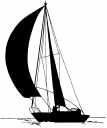 |
| If you have passengers (a crew), let them know what you want from
them in advance of any maneuver. If they need to move their weight
or help with the sails on a larger boat, explain what you want and
give a warning. For tacking, the traditional hail is READY ABOUT and
for jibing, PREPARE TO JIBE. |
Many beginners have trouble trimming sail because one
hand appears completely occupied in steering the boat. Use your thumb
and fore finger of the tiller hand to grasp the sheet temporarily
when you have to haul the sail in.
Many sails have yarn taped to both sides of the middle of the sail
just back from the luff. These SAIL TICKLERS are used to gauge wind
flow along the sail, and when they are working ideally, they will
be parallel and stream back toward the leech. If the windward yard
is spinning about, the sail is about to luff and you should trim in
or, if already trimmed into close-hauled, turn the boat away from
the wind direction. |
 |
| If the leeward yarn is spinning about as you observe it through
the translucent sail, your sail is in too tight and should be eased
or your course altered toward the wind.An improper sail set is a sure
sign of an inexperienced sailor. On the Tech it is very important
to get the sail to the top of the mast. |
 |
If the BOOM VANG is tight or the DOWNHAUL made fast
when you raise the sail, the sail will not go to the top of the mast.
If the sail is not to the top, your boom will be lower than it should
be, and there will be insufficient room between the tack of the sail
and the gooseneck to apply tension to the luff of the sail. The downhaul
should be tensioned enough to remove any wrinkles that radiate from
the luff toward the clew of the sail. These wrinkles indicate the
DRAFT (the maximum point of curvature in the sail) has moved too far
aft. |
| The stronger the wind, the more tension you will need on the DOWNHAUL
to keep out the wrinkles when the sail is full and pulling. The OUTHAUL
should also be adjusted according to the strength of the wind. For
light winds or rough water you want to develop more drive in the sail
by leaving 6 to 8 inches of curve between the point of maximum curve
of the foot of the sail and the boom. |
| As the wind increases and the boat becomes
overpowered, continue to tighten the outhaul and reduce the curve
in the sail to reduce the heeling force. Even if possible, it would
never be desirable to completely flatten the sail since, the sail
would not work if it was completely flat. The purpose of the BOOM
VANG is to prevent the top of the leech from twisting too far off
to leeward and spilling the wind. A little twist in the leech is desirable
in light winds, so the vang should not be set up tight in these conditions. |
 |
| The vang will be most important on reaches and runs when the main
sheet isn’t effective in applying a downward force on the sail.
As the wind increases, continue to tighten your vang to control leech
twist. The TRAVELER line should always be light enough so the traveler
blocks never come close to the boom blocks, and in actual practice,
most sailors will set the line tight enough so the traveler blocks
just clear over the top of the tiller on tacks and jibes. |
- Diagrams and Text courtesy of Sailing and the Tech Dinghy
- Permission granted by: Harold "Hatch" Brown, MIT.
- Black and white clipart were provided by
arttoday.com
- Created by: Nondini Naqui '02
- Maintained by: Bonnie Dix
- Date Created: 7/27/00
- Last Modified: 8/9/00
|
|




